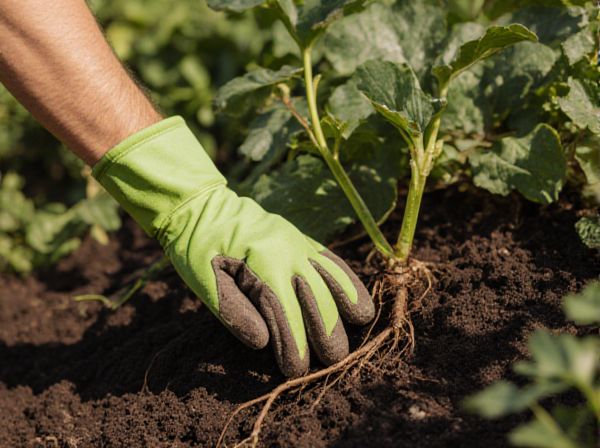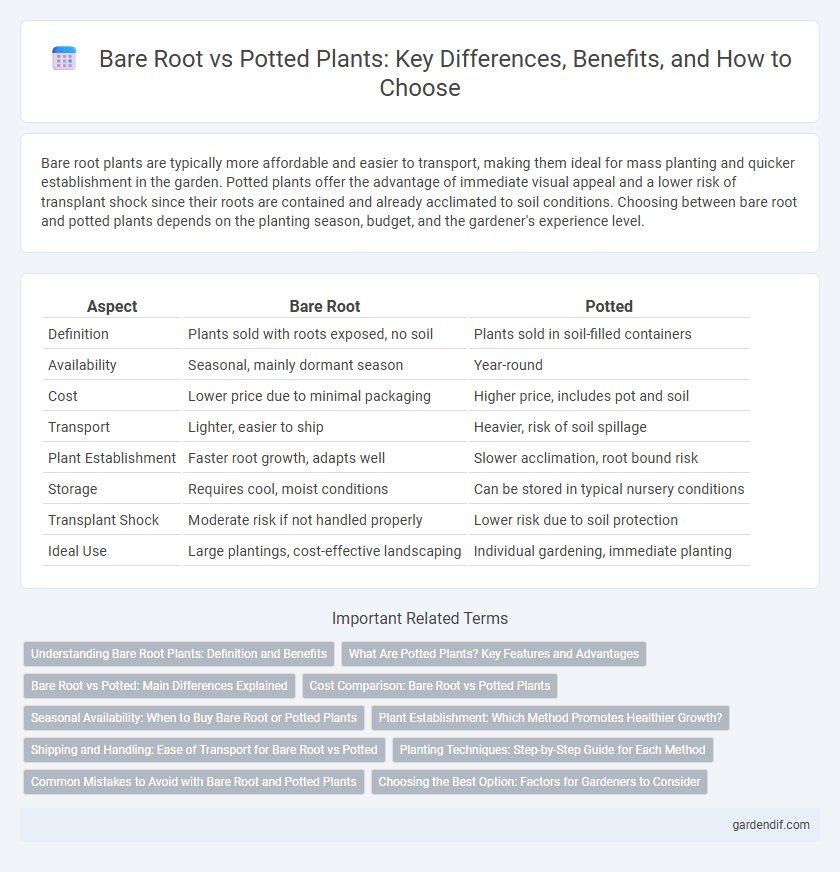
Bare Root vs Potted Illustration
Bare root plants are typically more affordable and easier to transport, making them ideal for mass planting and quicker establishment in the garden. Potted plants offer the advantage of immediate visual appeal and a lower risk of transplant shock since their roots are contained and already acclimated to soil conditions. Choosing between bare root and potted plants depends on the planting season, budget, and the gardener's experience level.
Table of Comparison
| Aspect | Bare Root | Potted |
|---|---|---|
| Definition | Plants sold with roots exposed, no soil | Plants sold in soil-filled containers |
| Availability | Seasonal, mainly dormant season | Year-round |
| Cost | Lower price due to minimal packaging | Higher price, includes pot and soil |
| Transport | Lighter, easier to ship | Heavier, risk of soil spillage |
| Plant Establishment | Faster root growth, adapts well | Slower acclimation, root bound risk |
| Storage | Requires cool, moist conditions | Can be stored in typical nursery conditions |
| Transplant Shock | Moderate risk if not handled properly | Lower risk due to soil protection |
| Ideal Use | Large plantings, cost-effective landscaping | Individual gardening, immediate planting |
Understanding Bare Root Plants: Definition and Benefits
Bare root plants are dormant plants sold without soil around their roots, making them lightweight and easier to transport. This method ensures better root visibility, allowing for precise inspection and healthier establishment after planting. The absence of soil reduces the risk of pests and diseases, promoting stronger growth and cost-effective planting.
What Are Potted Plants? Key Features and Advantages
Potted plants are cultivated and sold in containers filled with soil, providing a controlled environment for root development and moisture retention. Their key features include immediate transplanting ease, reduced transplant shock, and extended growing seasons due to maintained root systems and soil moisture. Advantages of potted plants include better establishment success, convenience for transport and handling, and availability year-round for gardeners and landscapers.
Bare Root vs Potted: Main Differences Explained
Bare root plants are sold without soil, exposing their roots, which allows for easier transportation and lower shipping costs compared to potted plants. Potted plants come with soil, providing immediate nourishment and reducing transplant shock, but they are heavier and more expensive to ship. Choosing between bare root and potted plants depends on factors like planting season, ease of handling, and long-term growth conditions.
Cost Comparison: Bare Root vs Potted Plants
Bare root plants typically cost 30-50% less than potted plants due to lower shipping and packaging expenses. Potted plants require soil-filled containers and more careful handling, increasing overall costs. Choosing bare root plants offers cost savings, especially for bulk purchases in landscaping and gardening projects.
Seasonal Availability: When to Buy Bare Root or Potted Plants
Bare root plants are typically available during late winter to early spring, allowing for easy transport and planting before the growing season begins. Potted plants can be purchased year-round, offering greater flexibility and immediate visual appeal since they are already established in soil. Choosing between bare root and potted depends on plant species and your regional climate, with bare root options being ideal for dormancy periods and potted plants suited for season-long planting and landscaping.
Plant Establishment: Which Method Promotes Healthier Growth?
Bare root plants often establish more quickly due to their direct root-to-soil contact, promoting vigorous root development and healthier growth in the first growing season. Potted plants, while convenient and less vulnerable to transplant shock, may experience slower root expansion because roots grow within the confined space of the container. Choosing between bare root and potted depends on the plant species and planting conditions, but bare root generally supports stronger establishment in optimal soil environments.
Shipping and Handling: Ease of Transport for Bare Root vs Potted
Bare root plants offer significantly easier and more cost-effective shipping due to their lightweight, compact form and lack of soil, reducing the risk of damage during transport. Potted plants require careful handling to prevent soil spillage and root disturbance, leading to bulkier packaging and higher shipping costs. This makes bare root plants a preferred choice for long-distance transport, especially in mail-order and commercial nurseries.
Planting Techniques: Step-by-Step Guide for Each Method
Bare root planting requires soaking roots in water before planting, digging a hole twice the width of the root system, positioning the roots carefully to avoid damage, and backfilling with soil while ensuring the crown is at ground level. Potted plants need removal from containers, loosening of root-bound soil, planting in a hole slightly larger than the pot to encourage root spread, and thorough watering to eliminate air pockets. Both methods benefit from mulching and regular watering to promote healthy establishment and growth.
Common Mistakes to Avoid with Bare Root and Potted Plants
Bare root plants require immediate planting to prevent drying out, while common mistakes include neglecting soil moisture and improper handling of delicate roots. Potted plants often suffer from overwatering and root-bound conditions due to infrequent repotting or inadequate drainage. Understanding these key differences ensures healthy establishment and growth in garden settings.
Choosing the Best Option: Factors for Gardeners to Consider
Choosing between bare root and potted plants depends on factors such as planting season, budget, and soil conditions. Bare root plants are often more affordable and easier to handle during dormant seasons, promoting strong root establishment, while potted plants provide immediate growth potential and can be planted year-round. Gardeners should assess site preparation, plant type, and long-term maintenance to select the best option for their landscaping needs.
Bare Root vs Potted Infographic

 gardendif.com
gardendif.com